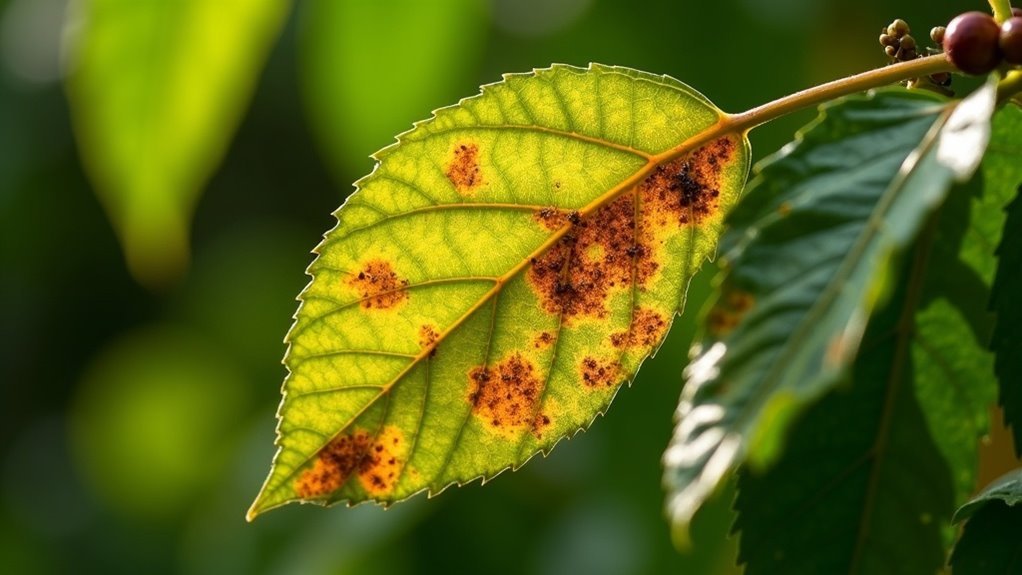Coffee rust disease is a significant challenge for coffee growers, caused by the fungus Hemileia vastatrix. This disease flourishes in humid environments and can drastically impact coffee yields, leading to reductions of 30% to 80%. Early signs include irregular yellow spots on the leaves that develop into larger lesions, causing premature leaf drop and diminishing the quality of the coffee beans. To effectively manage coffee rust, it is crucial to understand its life cycle and adopt preventive measures. There is a wealth of information available on best practices for controlling and mitigating the effects of coffee rust.
Key Takeaways
Coffee Rust Disease is a significant threat to global coffee production, caused by the fungus Hemileia vastatrix. This disease flourishes in humid conditions and can lead to dramatic yield reductions ranging from 30% to 80%. The symptoms of coffee rust include irregular yellow to orange spots on the leaves, which can cause premature leaf drop. The disease spreads quickly, aided by rain, wind, and animals, particularly in warm climates. To combat this issue, it is essential to implement preventive measures such as utilizing resistant coffee varieties, practicing sanitation, and employing Integrated Pest Management strategies.
Overview of Coffee Rust Disease
Coffee rust disease, caused by the fungus Hemileia vastatrix, poses a significant threat to global coffee production, given its history and impact.
This coffee rust fungus leads to coffee leaf rust, resulting in severe economic losses for coffee growers worldwide. First identified in Africa, it has spread to all major coffee plantations, devastating yields by 30% to 50%.
The rust infection thrives in humid conditions and is propagated by rain and wind.
Effective management of coffee rust requires understanding resistance mechanisms and implementing integrated strategies, including resistant varieties and cultural practices, to mitigate plant diseases and ensure sustainable coffee production.
Symptoms of Coffee Rust
When you observe coffee plants, the first indication of coffee rust disease is the presence of irregular yellow to orange spots on the upper leaf surfaces.
As the disease progresses, these spots expand into larger lesions, particularly visible on the undersides of the leaves, leading to premature leaf drop.
This symptomatology can vary greatly due to environmental conditions and the specific coffee plant variety you’re dealing with.
Understanding these signs is crucial for maintaining healthy coffee crops and ensuring a successful harvest.
Leaf Spot Characteristics
The symptoms of coffee rust disease, primarily characterized by leaf spot formation, directly impact the health of coffee plants. Infected leaves display irregular yellow to orange spots on their upper surfaces, with corresponding lesions on the underside.
As Hemileia vastatrix progresses, these spots merge, causing larger areas of necrosis, leading to leaf drying and browning. Initially, lower leaves show symptoms, but eventually, upper leaves are affected, resulting in premature leaf drop.
This reduction in leaf area can greatly decrease sunlight absorption, contributing to yield losses of 30% to 50%, severely impacting coffee production and fruit quality. Understanding these characteristics is crucial for coffee growers to effectively manage and mitigate the effects of coffee rust disease on their crops.
Progression of Symptoms
As symptoms of coffee rust disease develop, you’ll notice a distinct progression that begins with irregular yellow to orange lesions appearing primarily on the lower leaf surfaces of coffee plants. Infected leaves will show premature browning and drying, leading to significant leaf drop, which impairs the plant’s ability to photosynthesize effectively. The infection spreads upwards, exacerbated by high humidity and warm temperatures, which are common conditions in coffee-growing regions. Without timely intervention, yield loss can range from 30% to 50%, with severe cases resulting in total tree death.
| Stage of Progression | Symptoms |
|---|---|
| Initial | Yellow to orange lesions |
| Intermediate | Premature browning |
| Advanced | Leaf drop |
| Severe | Yield loss (30-50%) |
| Critical | Total tree death |
Environmental Influences on Disease
Environmental factors significantly influence the severity and spread of coffee rust disease, which is crucial for maintaining healthy coffee plants and ensuring optimal yields. High humidity and warm temperatures accelerate infection rates, with the ideal germination temperature for the fungus being around 21°C. This climate fosters the proliferation of the disease.
Additionally, monoculture practices can worsen the situation by reducing genetic diversity among coffee plants, allowing more virulent strains of the fungus to establish themselves.
As the disease progresses, symptoms typically include premature leaf drop, which leads to a decrease in photosynthesis and can result in yield losses ranging from 30% to 50%. Such losses not only reduce the quantity of coffee produced but also deplete non-structural carbohydrates, which are vital for the vigor of the plants and the quality of the coffee beans.
Ultimately, these factors pose a significant threat to coffee production, impacting both the industry and consumers.
Causes of Coffee Rust
While various factors contribute to the onset of coffee rust disease, the primary cause is the fungus Hemileia vastatrix. This pathogen thrives in high humidity, greatly affecting coffee production.
The fungus Hemileia vastatrix is the main culprit behind coffee rust disease, thriving in humid conditions and impacting production significantly.
The following factors exacerbate the situation:
- Rust spores spread through rain, wind, and animals.
- Warm, wet climates facilitate rapid dissemination.
- Initial lesions appear on lower leaves, reducing photosynthesis.
- Monoculture farming increases vulnerability to virulent strains.
- Human activities can unintentionally aid the spread.
Understanding these causes of coffee rust is essential for coffee enthusiasts and farmers alike, as it helps implement effective resistance mechanisms, ultimately protecting coffee plants from this debilitating disease.
Life Cycle of Hemileia Vastatrix
In understanding the life cycle of Hemileia vastatrix, you’ll see that it starts with spore germination on the coffee leaf surface within 24–48 hours.
The infection mechanism involves the spores penetrating through stomata and forming hyphae that extract nutrients from the coffee plant.
As the disease progresses, you can track a timeline of lesion formation and spore production, highlighting the rapid spread and impact of this pathogen on coffee crops.
Spore Germination Process
The spore germination process of Hemileia vastatrix is crucial for understanding the rapid spread of coffee rust disease, which affects coffee plants. Uredospores germinate within 24–48 hours on suitable leaf surfaces, forming appressoria that penetrate the substomatal cavity, initiating infection.
Key factors influencing this process include:
- Ideal temperatures of 13–31°C, peaking around 21°C, which are conducive to coffee growth.
- Requirement of free water on leaf surfaces, essential for maintaining healthy coffee plants.
- Generation of 4–6 spore crops from one lesion over 3–5 months, impacting coffee yield.
- Release of hundreds of thousands of spores, facilitating disease spread among coffee crops.
- Continuous life cycle in favorable conditions, leading to exponential spore population increases, which can threaten coffee production.
Understanding these factors is vital for coffee growers to manage and mitigate the impact of coffee rust disease on their crops.
Infection Mechanism Overview
Understanding the spore germination process is crucial for examining the infection mechanism of Hemileia vastatrix, a significant threat to coffee plants.
Once uredospores come into contact with coffee plants, they germinate and infiltrate through stomata within 24–48 hours. The fungus produces yellow-orange mycelium and forms uredinia, leading to chlorotic lesions on the coffee leaves. Mycelia grow intercellularly, creating haustoria that extract essential nutrients from the plant, progressively inducing cell death.
Each lesion can produce 4–6 spore crops over 3–5 months, releasing vast quantities of spores that perpetuate the infection cycle. Notably, H. vastatrix is autoecious, relying solely on coffee plants for its life cycle.
This emphasizes the need for vigilant management strategies against coffee rust to protect coffee crops and ensure healthy yields.
Disease Progression Timeline
As uredospores germinate on coffee leaves, they initiate a rapid progression of Hemileia vastatrix’s life cycle, setting the stage for severe infection. Within 24-48 hours of moisture accumulation, you’ll observe the following:
- Initial lesions manifest as pale yellow spots on upper leaf surfaces, impacting the aesthetic quality of the coffee plants.
- Yellow-orange, powdery mycelium forms beneath the lesions, indicating the fungus’s presence and its potential threat to coffee crops.
- A single lesion can produce multiple spore crops within 3-5 months, leading to widespread infection across coffee plantations.
- The fungus thrives in warm, humid conditions, with ideal temperatures between 13-31°C, conditions commonly found in coffee-growing regions.
- Disease progression leads to premature leaf drop, considerably reducing coffee yield by 30% to 80%, severely impacting both the quality and quantity of coffee production.
Understanding this disease progression is crucial for coffee farmers to implement effective management strategies and protect their crops.
Prevention Strategies for Coffee Rust
While cultivating coffee, adopting effective prevention strategies for coffee rust is vital to safeguard your crops and ensure maximum yields. Maintaining healthy plants through sanitation practices, such as weed removal and proper pruning, significantly reduces infection risks. Implementing Integrated Pest Management (IPM) by utilizing resistant varieties and biopesticides is essential. Regular monitoring allows for the identification of weak plants for removal, preventing the spread of rust. Additionally, incorporating shade trees can enhance nutrition and reduce humidity, further limiting coffee rust. It is advisable to consult local agricultural advisors for personalized recommendations.
| Strategy | Description |
|---|---|
| Sanitation Practices | Remove weeds and prune for improved airflow |
| Resistant Varieties | Utilize coffee plants bred for enhanced rust resistance |
| Integrated Pest Management | Combine cultural practices with biopesticides |
| Monitoring | Regularly inspect plants and remove any diseased specimens |
Management Solutions for Coffee Rust
Effective management solutions for coffee rust disease necessitate a multifaceted approach that integrates various strategies to combat this pervasive threat to coffee production.
For coffee producers, adopting Integrated Pest Management (IPM) is essential. Key strategies include:
- Utilizing resistant coffee plant varieties
- Implementing effective cultural practices, such as pruning and nutrition management tailored for coffee
- Incorporating biopesticides as sustainable alternatives for coffee cultivation
- Monitoring for early detection and response specific to coffee rust
- Collaborating with agricultural experts focused on coffee for adaptive management
While chemical fungicides can control outbreaks of coffee rust, they risk developing resistant populations of Hemileia vastatrix.
Balancing these methods will enhance coffee plant protection and guarantee sustainable coffee production amidst rust challenges.
Role of Resistant Varieties and Biocontrol Methods
How can resistant coffee varieties and biocontrol methods reshape the landscape of coffee production?
By incorporating F1 hybrids like Starmaya, coffee farmers can effectively combat coffee rust, significantly enhancing yields.
Breeding programs focus on developing durable plant resistance against all races of Hemileia vastatrix, ensuring sustainability in coffee cultivation.
Additionally, the use of biocontrol methods, including beneficial bacteria and mycoparasitic fungi, aids in managing coffee rust while decreasing reliance on chemical fungicides.
This holistic approach fosters an Integrated Pest Management (IPM) strategy, promoting ecological balance and reducing economic losses in coffee farming.
Adopting these innovative strategies is essential for maintaining resilient coffee production amid the ongoing challenges posed by coffee rust disease.








